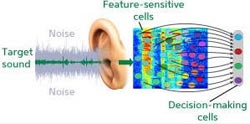Following the brain’s lead

A brain-based pattern-recognition process that searches for familiar features in the audio spectrum improves sound recognition in computers. <br>Copyright : 2013 A*STAR Institute for Infocomm Research <br>
Computers, machines and even smart phones can process sounds and audio signals with apparent ease, but they all require significant computing power.
Researchers from the A*STAR Institute for Infocomm Research in Singapore have proposed a way to improve computer audio processing by applying lessons inspired from the way the brain processes sounds.
“The method proposed in our study may not only contribute to a better understanding of the mechanisms by which the biological acoustic systems operate, but also enhance both the effectiveness and efficiency of audio processing,” comments Huajin Tang, an electrical engineer from the research team.
When listening to someone speaking in a quiet room, it is easy to identify the speaker and understand their words. While the same words spoken in a loud bar are more difficult to process, our brain is still capable of distinguishing the voice of the speaker from the background noise. Computers, on the other hand, still have considerable problems identifying complex sounds from a noisy background; even smart phones must send audio signals to a powerful centralized server for processing.
Considerable computing power at the server is required because the computer continuously processes the entire spectrum of human audio frequencies. The brain, however, analyzes information more selectively: it processes audio patterns localized in time and frequency (see image). When someone speaks with a deep voice, for example, the brain dispenses with analyzing high-pitched sounds. So when a speaker in a loud bar stops talking, the brain stops trying to catch and process the sounds that form his words.
Tang and his team emulated the brain’s sound-recognition strategy by identifying key points in the audio spectrum of a sound. These points could be characteristic frequencies in a voice or repeating patterns, such as those of an alarm bell. They analyzed the signal in more detail around these key points only, looking for familiar audio frequencies as well as time patterns. This analysis enabled a robust extraction of matching signals when a noise was present. To improve the detection over time, the researchers fed matching frequency patterns into a neurological algorithm that mimics the way the brain learns through the repetition of known patterns.
In computer experiments, the algorithm successfully processed known target signals, even in the presence of noise. Expanding this approach, says Tang, “could lead to a greater understanding of the way the brain processes sound; and, beyond that, it could also include touch, vision and other senses.”
Journal information
Dennis, J., Yu, Q., Tang, H., Tran, H. D. & Li, H. Temporal coding of local spectrogram features for robust sound recognition. 2013 IEEE International Conference on Acoustics, Speech and Signal Processing, 26–31 May 2013.
Media Contact
All latest news from the category: Interdisciplinary Research
News and developments from the field of interdisciplinary research.
Among other topics, you can find stimulating reports and articles related to microsystems, emotions research, futures research and stratospheric research.
Newest articles

NASA: Mystery of life’s handedness deepens
The mystery of why life uses molecules with specific orientations has deepened with a NASA-funded discovery that RNA — a key molecule thought to have potentially held the instructions for…

What are the effects of historic lithium mining on water quality?
Study reveals low levels of common contaminants but high levels of other elements in waters associated with an abandoned lithium mine. Lithium ore and mining waste from a historic lithium…

Quantum-inspired design boosts efficiency of heat-to-electricity conversion
Rice engineers take unconventional route to improving thermophotovoltaic systems. Researchers at Rice University have found a new way to improve a key element of thermophotovoltaic (TPV) systems, which convert heat…



